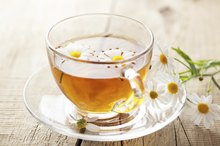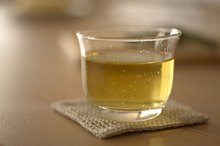Benefits of Taking Sage Extract for Excessive Sweating
Excessive sweating, clinically known as hyperhidrosis, is characterized by profuse sweating of the face, feet, underarms or, most commonly, the palms. Aside from discomfort, this condition can have significant emotional and social impact for some people. In severe cases, treatment typically consists of thoracic sympathectomy, which involves the removal or resecting of sympathetic nerves. However, mild cases may respond to therapy with sage extract. Explore all of your treatment options with your doctor, though, and note that this herb is not suitable to use during pregnancy or lactation.
Antihydrotic Properties
According to the “Physicians’ Desk Reference for Herbal Medicines,” the active compounds in the volatile oils obtained from the leaves and aerial parts of the sage plant consist of a 20 to 60 percent concentration of alpha-thujone and beta-thujone, and lesser amounts of 1,8-cineole, linalool, rosmarinic acid and several other phytochemicals. Collectively, these agents exert astringent, antibacterial, antifungal and antihydrotic effects, the latter meaning to inhibit perspiration. Using sage to treat excessive sweating due to various causes, including clinical hyperhidrosis, is a traditional remedy with a long history. Today, the German Commission E, the European equivalent of the U.S. Federal Drug Administration, approves the use of sage extracts to treat excessive sweating.
- According to the “Physicians’ Desk Reference for Herbal Medicines,” the active compounds in the volatile oils obtained from the leaves and aerial parts of the sage plant consist of a 20 to 60 percent concentration of alpha-thujone and beta-thujone, and lesser amounts of 1,8-cineole, linalool, rosmarinic acid and several other phytochemicals.
Reduced Hot Flashes
Sage Tea for Sweating
Learn More
Excessive perspiration isn’t always blamed on a condition like hyperhidrosis. In fact, a common and similar event is often experienced during menopause in the form of hot flashes. As the term implies, hot flashes are described as a sudden flushing of the skin followed by profuse sweating, usually about the face and torso. In herbal medicine, sage is a traditional treatment for hot flashes, sometimes in combination with other herbs.
- Excessive perspiration isn’t always blamed on a condition like hyperhidrosis.
- As the term implies, hot flashes are described as a sudden flushing of the skin followed by profuse sweating, usually about the face and torso.
Less Night Sweats
Sage is also traditionally used to reduce the frequency of night sweats, another symptom associated with menopause. Of course, unlike hot flashes, night sweats occur exclusively during sleep. In addition, according to a monograph provided by the Plants For A Future Organization, sage is used to counter excessive nighttime perspiration triggered by symptoms of tuberculosis, such as persistent cough and fever.
- Sage is also traditionally used to reduce the frequency of night sweats, another symptom associated with menopause.
- In addition, according to a monograph provided by the Plants For A Future Organization, sage is used to counter excessive nighttime perspiration triggered by symptoms of tuberculosis, such as persistent cough and fever.
Complementary Benefits
Manzanilla Tea Benefits
Learn More
In a review published in the May-June 2002 issue of the “European Journal of Dermatology,” Barbara Togel and colleagues wrote that drinking at least 1 liter of sage tea per day sometimes helps to reduce excessive sweating caused by localized and generalized forms of hyperhidrosis 3. In addition, the practice is a suitable adjunctive therapy to conventional treatments for excessive sweating and a non-invasive alternative to surgical procedures.
According to the PDR, an antihydrotic infusion of sage can be prepared from steeping 1 liter of boiling water with 20 g of fresh sage leaves. Alternatively, the average daily dose of the liquid extract is 1 to 3 g mixed with tea or other liquid.
- In a review published in the May-June 2002 issue of the “European Journal of Dermatology,” Barbara Togel and colleagues wrote that drinking at least 1 liter of sage tea per day sometimes helps to reduce excessive sweating caused by localized and generalized forms of hyperhidrosis 3.
- According to the PDR, an antihydrotic infusion of sage can be prepared from steeping 1 liter of boiling water with 20 g of fresh sage leaves.
Related Articles
References
- “PDR for Herbal Medicines”; Thomas Fleming, et al; 2000
- pfaf.org: Salvia officinalis - L.
- “European Journal of Dermatology”; Current therapeutic strategies for hyperhidrosis; Togel B et al.; May-June 2002
- National Center for Complementary and Integrative Health. Sage.
- Lopresti AL. Salvia (sage): a review of its potential cognitive-enhancing and protective effects. Drugs in R&D. 2017;17(1):53–64. doi:10.1007/s40268-016-0157-5
- Hamidpour M, Hamidpour R, Hamidpour S, Shahlari M. Chemistry, pharmacology, and medicinal property of sage (salvia) to prevent and cure illnesses such as obesity, diabetes, depression, dementia, lupus, autism, heart disease, and cancer. J Tradit Complement Med. 2014;4(2):82–88. doi:10.4103/2225-4110.130373
- Tildesley NTJ, Kennedy DO, Perry EK, Ballard CG, Wesnes KA, Scholey AB. Positive modulation of mood and cognitive performance following administration of acute doses of Salvia lavandulaefolia essential oil to healthy young volunteers. Physiol Behav. 2005;83(5):699-709. doi:10.1016/j.physbeh.2004.09.010
- Modabbernia A, Akhondzadeh S. Saffron, passionflower, valerian and sage for mental health. Psychiatr Clin North Am. 2013;36(1):85-91. doi:10.1016/j.psc.2012.12.007
Writer Bio
Karyn Maier is a seasoned columnist and feature writer. Since 1992, her work has appeared in Mother Earth News, The Herb Quarterly, Better Nutrition and in many other print and digital publications. She is also the author of five books, and is published in six languages.








